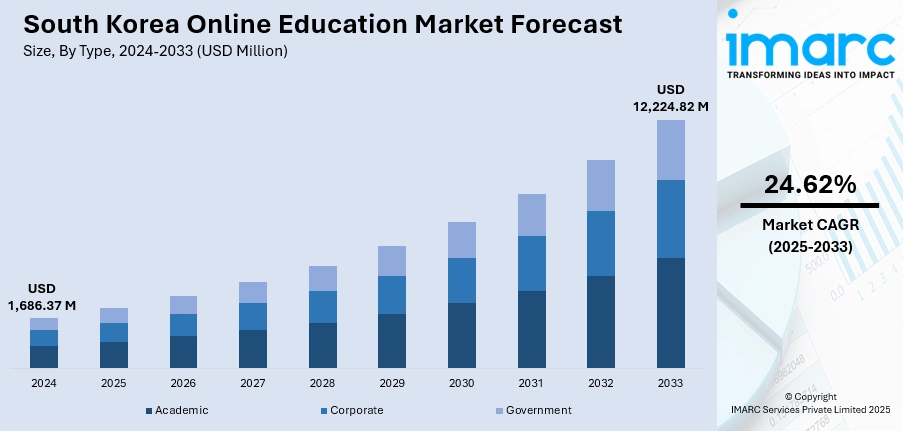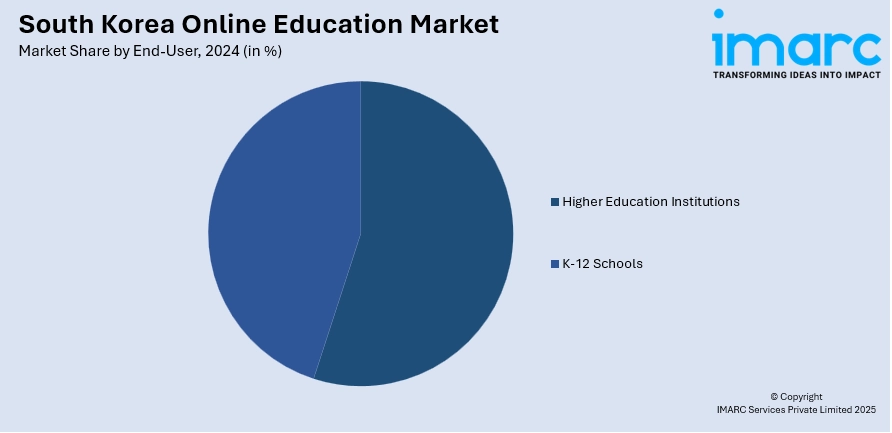
South Korea Online Education Market Size, Share, Trends and Forecast by Type, Provider, Technology, End-User, and Region, 2025-2033
South Korea Online Education Market Overview:
The South Korea online education market size reached USD 1,686.37 Million in 2024. The market is projected to reach USD 12,224.82 Million by 2033, exhibiting a growth rate (CAGR) of 24.62% during 2025-2033. The market is fueled by the high penetration rate of the internet in the country and extensive digital infrastructure, facilitating smooth access to online learning platforms. Besides this, the growing demand among students and professionals for customized and flexible learning has fueled the adoption of e-learning solutions. Also, the adoption of government programs favoring digital education and investment in AI-driven learning technologies further expands the South Korea online education market share.
|
Report Attribute
|
Key Statistics
|
|---|---|
|
Base Year
|
2024
|
|
Forecast Years
|
2025-2033
|
|
Historical Years
|
2019-2024
|
| Market Size in 2024 | USD 1,686.37 Million |
| Market Forecast in 2033 | USD 12,224.82 Million |
| Market Growth Rate 2025-2033 | 24.62% |
South Korea Online Education Market Trends:
Growth of Mobile Learning and Microlearning
Mobile learning has emerged as a key trend in the South Korean online learning industry, fuelled by the increased penetration of smartphone and tablet usage with 5G connectivity. According to industry reports, South Korea, which introduced 5G service in 2019, had approximately 32 million 5G subscribers as of 2023. The ease of learning remotely has made mobile platforms very popular, particularly among working professionals and students. In addition to this, mobile-optimized websites and education apps provide flexibility through access anywhere, anytime. Apart from this, microlearning, or focused learning in short modules, is one major aspect of this trend. By segmenting content into manageable blocks, mobile platforms for learning enable learners to understand information in bite-sized chunks, which is easier to incorporate into routine lives. This method appeals to short attention spans and ensures improved retention. Furthermore, mobile learning also enables gamification aspects, further triggering user motivation and participation. This trend is changing conventional learning models, as students find it more appealing to learn using their mobile devices.

To get more information on this market, Request Sample
Integration of Artificial Intelligence (AI) and Personalized Learning
The integration of artificial intelligence (AI) to personalize learning experiences is positively impacting the South Korea online education market growth. For instance, in February 2023, South Korea’s Ministry of Education (MOE) unveiled an initiative focused on personalized learning through artificial intelligence (AI) and digital technologies. The government has also revealed plans to spend USD 69.3 Million by 2026 to enhance the infrastructure for digital classrooms. Furthermore, an additional USD 43.2 Million will be directed toward assisting 6,000 primary and secondary schools across the country in establishing AI textbook monitoring systems and training 1,200 digital tutors to effectively manage digital devices. AI-powered platforms are used to create adaptive learning systems that cater to individual student needs, adjusting the difficulty of tasks based on real-time performance. This trend allows for a more tailored educational experience, ensuring that students can progress at their own pace. By leveraging AI algorithms, platforms can analyze vast amounts of student data to recommend personalized content, track learning behaviors, and provide instant feedback. This approach is transforming how lessons are delivered, offering more dynamic and responsive educational environments. Moreover, AI is also used in automated assessment, grading tools, and chatbots that support interaction with the students. AI platforms also aid teachers in tracking the progress of students, which can result in more effective teaching methods and better student performance.
South Korea Online Education Market Segmentation:
IMARC Group provides an analysis of the key trends in each segment of the market, along with forecasts at the country and regional levels for 2025-2033. Our report has categorized the market based on type, provider, technology, and end-user.
Type Insights:
- Academic
- Higher Education
- Vocational Training
- K-12 Education
- Corporate
- Large Enterprises
- SMBs
- Government
The report has provided a detailed breakup and analysis of the market based on the type. This includes academic (higher education, vocational training, and k-12 education), corporate (large enterprises and SMBs), and government.
Provider Insights:
- Content
- Services
A detailed breakup and analysis of the market based on the provider have also been provided in the report. This includes content and services.
Technology Insights:
- Mobile E-Learning
- Rapid E-Learning
- Virtual Classroom
- Others
The report has provided a detailed breakup and analysis of the market based on the technology. This includes mobile E-learning, rapid E-learning, virtual classroom, and others.
End-User Insights:

- Higher Education Institutions
- K-12 Schools
A detailed breakup and analysis of the market based on the end-user have also been provided in the report. This includes higher education institutions and k-12 schools.
Regional Insights:
- Seoul Capital Area
- Yeongnam (Southeastern Region)
- Honam (Southwestern Region)
- Hoseo (Central Region)
- Others
The report has also provided a comprehensive analysis of all the major regional markets, which include Seoul Capital Area, Yeongnam (Southeastern Region), Honam (Southwestern Region), Hoseo (Central Region), and others.
Competitive Landscape:
The market research report has also provided a comprehensive analysis of the competitive landscape. Competitive analysis such as market structure, key player positioning, top winning strategies, competitive dashboard, and company evaluation quadrant has been covered in the report. Also, detailed profiles of all major companies have been provided.
South Korea Online Education Market News:
- On March 19, 2025, South Korea’s leading metaverse-based EdTech platform, ZEP QUIZ, officially launched in Thailand following a successful beta period, during which it recorded approximately 500,000 plays. The service had already achieved over 1 million plays across Southeast Asia within a month of its Indonesia debut, demonstrating robust regional traction. With localized content tailored to Thai users and its proven AI‑powered quiz tools, ZEP QUIZ aims to enhance interactive, game‑based learning experiences in the Thai education market.
- On July 29, 2025, Seomjae, a Seoul-based education solutions developer, will begin beta testing its AI-powered mathematics learning program, which includes over 120,000 math problems and 30,000 lectures, providing personalized learning pathways. The program, created over a span of two years by a team of 40 specialists, uses an AI Retrieval-Augmented Generation model to enhance learning.
South Korea Online Education Market Report Coverage:
| Report Features | Details |
|---|---|
| Base Year of the Analysis | 2024 |
| Historical Period | 2019-2024 |
| Forecast Period | 2025-2033 |
| Units | Million USD |
| Scope of the Report |
Exploration of Historical Trends and Market Outlook, Industry Catalysts and Challenges, Segment-Wise Historical and Future Market Assessment:
|
| Types Covered |
|
| Providers Covered | Content, Services |
| Technologies Covered | Mobile E-Learning, Rapid E-Learning, Virtual Classroom, Others |
| End-Users Covered | Higher Education Institutions, K-12 Schools |
| Regions Covered | Seoul Capital Area, Yeongnam (Southeastern Region), Honam (Southwestern Region), Hoseo (Central Region), Others |
| Customization Scope | 10% Free Customization |
| Post-Sale Analyst Support | 10-12 Weeks |
| Delivery Format | PDF and Excel through Email (We can also provide the editable version of the report in PPT/Word format on special request) |
Key Questions Answered in This Report:
- How has the South Korea online education market performed so far and how will it perform in the coming years?
- What is the breakup of the South Korea online education market on the basis of type?
- What is the breakup of the South Korea online education market on the basis of provider?
- What is the breakup of the South Korea online education market on the basis of technology?
- What is the breakup of the South Korea online education market on the basis of end-user?
- What is the breakup of the South Korea online education market on the basis of region?
- What are the various stages in the value chain of the South Korea online education market?
- What are the key driving factors and challenges in the South Korea online education market?
- What is the structure of the South Korea online education market and who are the key players?
- What is the degree of competition in the South Korea online education market?
Key Benefits for Stakeholders:
- IMARC’s industry report offers a comprehensive quantitative analysis of various market segments, historical and current market trends, market forecasts, and dynamics of the South Korea online education market from 2019-2033.
- The research report provides the latest information on the market drivers, challenges, and opportunities in the South Korea online education market.
- Porter's five forces analysis assist stakeholders in assessing the impact of new entrants, competitive rivalry, supplier power, buyer power, and the threat of substitution. It helps stakeholders to analyze the level of competition within the South Korea online education industry and its attractiveness.
- Competitive landscape allows stakeholders to understand their competitive environment and provides an insight into the current positions of key players in the market.
Need more help?
- Speak to our experienced analysts for insights on the current market scenarios.
- Include additional segments and countries to customize the report as per your requirement.
- Gain an unparalleled competitive advantage in your domain by understanding how to utilize the report and positively impacting your operations and revenue.
- For further assistance, please connect with our analysts.
 Request Customization
Request Customization
 Speak to an Analyst
Speak to an Analyst
 Request Brochure
Request Brochure
 Inquire Before Buying
Inquire Before Buying




.webp)




.webp)












